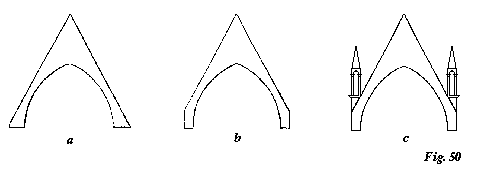CONSTRUCTION XVIII. PROTECTION 237
since, in Venice, the porch of the church of St. Apollinare, also to put up some Renaissance upholstery: for Renaissance, as if it were not nuisance enough in the mere fact of its own existence, appears invariably as a beast of prey, and founds itself on the ruin of all that is best and noblest. Many such porches, however, happily still exist in Italy, and are among its principal glories.
§ 7. When porches of this kind, carried by walls, are placed close together, as in cases where there are many and large entrances to a cathedral front, they would, in their general form, leave deep and uncomfortable intervals, in which damp would lodge and grass grow; and there would
 |
be a painful feeling in approaching the door in the midst of a crowd, as if some of them might miss the real doors, and be driven into the intervals, and embayed there. Clearly it will be a natural and right expedient, in such cases, to open the walls of the porch wider, so that they may correspond in slope, or nearly so, with the bevel of the doorway, and either meet each other in the intervals, or have the said intervals closed up with an intermediate wall, so that nobody may get
Uguccione, the superintendent of the building, for the purpose, as he stated, of re-erecting it in the then modern style; “so eager was he to effect the demolition, that, instead of detaching the precious marbles, which might have been employed again, the facing was plucked off so rudely and hastily that, according to a contemporary, not a slab or column was left entire.” In 1636 another façade was begun, but the works were suspended, and so remained until 1887. A careful pencil drawing of what is called Giotto’s façade, and which may have been built from his designs, is in the Opera del Duomo, and it may also be seen in the background of a lunette in the convent of S. Marco.]
[Version 0.04: March 2008]